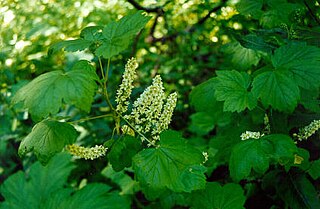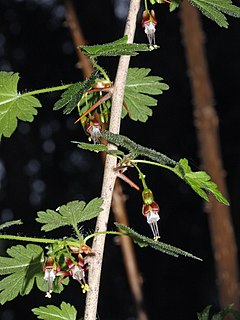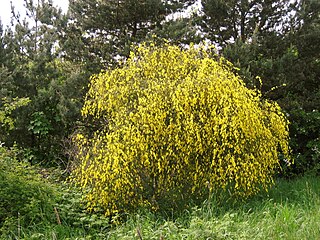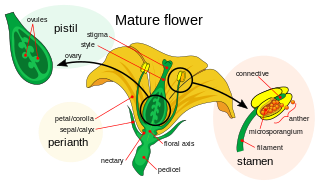
Ribes menziesii, the canyon gooseberry, is a species of currant found only in California and Oregon. There are five to six varieties of the species found across the low elevation mountains of California, especially the Coast Ranges, and the coastal canyons and foothills, into southern Oregon. It can be found in the chaparral plant community.

Hulsea algida is a species of flowering plant in the daisy family, known by the common name Pacific hulsea or alpine gold.
Chaenactis nevadensis, with the common name Nevada dustymaiden, is a North American species of flowering plant in the daisy family.
Ribes amarum is a species of currant known by the common name bitter gooseberry. It is endemic to California, where it is known from mountains, foothills, and canyons. Its habitat includes Chaparral.
Ribes binominatum is a species of currant known by the common names trailing gooseberry and ground gooseberry.
Ribes canthariforme is a rare North American species of currant known by the common name Moreno currant.

Ribes cereum is a species of currant known by the common names wax currant and squaw currant. It is native to western North America, including British Columbia, Alberta, and much of the western United States, from Washington, Oregon, and California east as far as the western Dakotas and the Oklahoma Panhandle.

Ribes hudsonianum is a North American species of currant, known by the common name northern black currant.

Ribes indecorum is a species of currant known by the common names white-flowered currant and white chaparral currant. It is native to the southern California Coast Ranges, Transverse Ranges, and Peninsular Ranges, from around Santa Barbara County in California south into northern Baja California.

Ribes inerme is a species of currant known by the common names whitestem gooseberry and white stemmed gooseberry. It is native to western North America from British Columbia to California to the Rocky Mountains. It grows in mountain forests, woodlands, and meadows.
Ribes lasianthum is a species of currant known by the common names alpine gooseberry and woolly-flowered gooseberry. It is native to California, where it can be found in the San Gabriel Mountains and the Sierra Nevada, its distribution extending just into Nevada.

Ribes laxiflorum is a species of currant known by the common names trailing black currant, and spreading currant. It is native to western North America from Alaska and Yukon south as far as northern California and New Mexico; it has also been found in Siberia. Its habitat includes moist mountain forests, open clearings, streambanks, and the borders of mountain roads.

Ribes montigenum is a species of currant known by the common names mountain gooseberry, alpine prickly currant, western prickly gooseberry,and gooseberry currant. It is native to western North America from Washington south to California and east as far as the Rocky Mountains, where it grows in high mountain habitat types in subalpine and alpine climates, such as forests and talus. It is a spreading shrub growing up to 1.5 meters tall, the branching stems covered in prickles and hairs and bearing 1 to 5 sharp spines at intervals.

Ribes quercetorum is a species of currant known by the common names rock gooseberry, oak gooseberry and oakwoods gooseberry. It is native to the mountains and hills of California from the San Francisco Bay Area south into Baja California and east into Arizona.

Ribes roezlii is a North American species of currant known by the common name Sierra gooseberry.
Ribes sericeum is a species of currant known by the common name Lucia gooseberry, or Santa Lucia gooseberry; its Latin epithet of sericeum means "of silk". It is endemic to California, where it is known only from the Santa Lucia Mountains along the Central Coast and an additional isolated population in Santa Barbara County.

Ribes velutinum is a species of currant known by the common name desert gooseberry.

Ribes viscosissimum is a North American species of currant known by the common name sticky currant. It is native to western Canada and the western United States from British Columbia and Alberta south as far as California, Arizona, and Colorado.
Silene bridgesii is a species of flowering plant in the pink family known by the common name Bridges' catchfly. It is native to California, where it can be found throughout the Sierra Nevada and the southern reaches of the Cascade Range to the north, its distribution possibly extending into Oregon. It grows in mountain forests and woodlands. It is a perennial herb growing from a taproot and woody caudex unit, its stem decumbent or growing erect to half a meter or more in height. It is hairy, the upper hairs glandular, making the plant sticky in texture. The lower leaves are widely lance-shaped, up to 8 centimeters long by 1.5 wide. Upper leaves are smaller. Flowers occur in a terminal cyme at the top of the stem, as well as in some of the leaf axils, where they nod or hang like a bell. Each has a hairy, glandular calyx of fused sepals with ten veins. The calyx is open at the tip, revealing five white, pinkish, or greenish petals each with two rectangular lobes at the tip. The very long stamens and three styles protrude from the flower's center.

Ribes americanum is a North American species of flowering plant in the gooseberry family known by the common names American black currant, wild black currant, and eastern black currant. It is widespread in much of Canada, the northern United States.




















